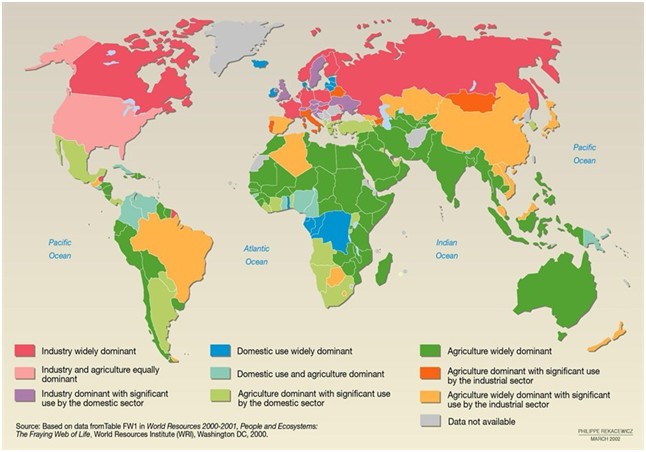Freshwater use by sector at the beginning of the 2000s

The agricultural sector is by far the biggest user of freshwater. Analysis indicates that: - In the United States, agriculture accounts for some 49% of total freshwater use, with 80% of this volume being used for irrigation (Shiklomanov, 1999). - In Africa and Asia, an estimated 85-90% of all freshwater used is for agriculture (Shiklomanov, 1999). - According to estimates for the year 2000, agriculture accounted for 67% of the world’s total freshwater withdrawal, and 86% of its consumption (UNESCO, 2000). - By 2025, agriculture is expected to increase its water requirements by 1.3 times, industry by 1.5 times, and domestic consumption by 1.8 times (Shiklomanov, 1999). - The world’s irrigation areas totalled approximately 253 million hectares in 1995. By 2010, they are expected to reach about 290 million hectares, and by 2025 about 330 million hectares (Shiklomanov, 1999). - By the year 2000, an estimated 15% of the world’s cultivated lands had been irrigated for food crops, accounting for almost half the value of global crop production (UNESCO, 1999). In the industrial sector, the biggest share of freshwater is stored in reservoirs and dams for electrical power generation and irrigation. However, the volume of water evaporated from reservoirs is estimated to exceed the combined freshwater needs of industry and domestic consumption. This greatly contributes to water losses around the world, especially in hot tropical regions (UNESCO, 1999). Industrial uses account for about 20% of global freshwater withdrawals. Of this, 57-69% is used for hydropower and nuclear power generation, 30-40% for industrial processes, and 0.5-3% for thermal power generation (Shiklomanov, 1999). Domestic water use is related to the quantity of water available to populations in cities and towns. Analysis indicates that: - People in developed countries on average consume about 10 times more water daily than those in developing countries. It is estimated that the average person in developed countries uses 500-800 litres per day (300 m3 per year), compared to 60-150 litres per day (20 m3 per year) in developing countries (UNESCO, 2000). - In large cities with a centralized water supply and an efficient canalization system, domestic consumption does not usually represent more than 5-10% of the total water withdrawal (intake) (UNESCO, 2000). - Water withdrawal in large cities is estimated at 300-600 litres per person per day, while small cities have a water withdrawal of 100-150 litres per day, and consumption can reach 40-60% of the total water intake (UNESCO, 2000). - In developing countries in Asia, Africa and Latin America, public water withdrawal represents just 50-100 litres per person per day. In regions with insufficient water resources, this figure may be as low as 20-60 litres per day (UNESCO, 2000). is related to the quantity of water available to populations in cities and towns. Analysis indicates that: - People in developed countries on average consume Managing water resources using an integrated river basin management approach is the most sustainable way of ensuring ecosystem integrity. In this respect, there is a need to consider the economic value of freshwater ecosystems, including for fisheries, wildlife habitats, recreation and natural flood control.
